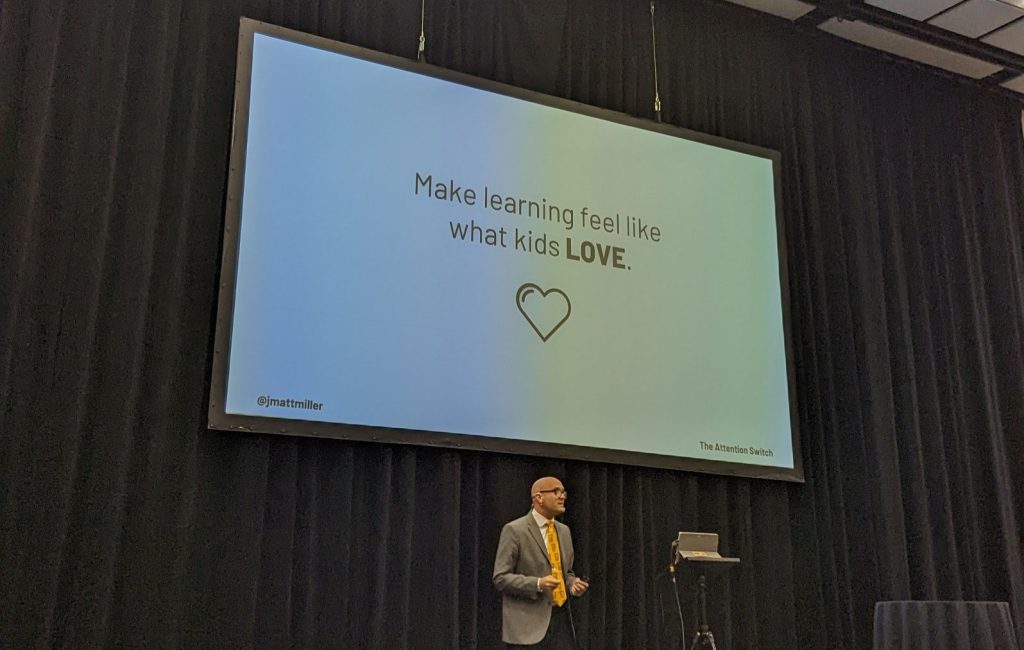Le 18 novembre dernier, nous avons assisté à la conférence d’ouverture du 50ᵉ congrès de SPEAQ (la Société pour le perfectionnement de l’anglais langue seconde au Québec). Petit retour sur cet inspirant moment animé par nul autre que Matt Miller.
Si vous ne connaissez pas Matt Miller, vous connaissez peut-être son blogue Ditch That Texbook, à travers lequel, depuis des années, il alimente la communauté éducative d’idées pédagogiques créatives pour tirer profit du numérique en éducation. Lui-même enseignant de langue seconde au secondaire (en espagnol) à l’origine, il est aussi l’auteur de cinq livres. Comme pour plusieurs d’entre nous, ce sont justement ses participations à des congrès, formations et conférences qui ont allumé en lui cette flamme et cette passion pour ce qu’il fait aujourd’hui.
Lors de sa conférence, il a parlé de l’attention, et plus particulièrement de la difficulté d’obtenir l’attention des gens, mais encore plus des élèves, depuis l’arrivée du cellulaire. Même l’industrie de la publicité a dû se battre contre ce nouvel outil et est allé jusqu’à mettre des publicités aux endroits où nous sommes le plus captif, soit les toilettes publiques! Les publicistes ont dû user de créativité; imaginez les enseignants avec les élèves, alors!
Les jeunes sont conditionnés à recevoir une gratification instantanée avec les outils numériques. Par contre, nous avons tous un interrupteur d’attention, quelque chose qui nous allume suffisamment pour nous faire lever les yeux de notre écran. Il faut donc trouver, chez les élèves, ce qui allumera leur attention en classe, ce qui les rendra engagés et connectés à leur apprentissage. À ce moment, ils n’auront même pas l’impression de travailler, comme le rappelle Matt.
S’inspirer de ce qui allume les jeunes
Il propose ainsi aux pédagogues de s’inspirer de ce qui allume les élèves pour capter leur attention. Pour ce faire, nul besoin d’une application en particulier : souvent, le principe de base suffit! Quelques années auparavant, les Vines étaient bien populaires (Matt surnomme l’application la grand-mère de TikTok 🙂). Le principe était simple : raconter une histoire ou un concept en six secondes. L’application était impossible à utiliser en salle de classe, car l’âge minimum requis était de 17 ans.
Pourtant, les élèves de Matt y étaient presque tous et adoraient le concept. Plutôt que de faire de vrais « Vines », Matt s’est inspiré du concept pour faire réaliser de courtes vidéos de six secondes sur des notions de vocabulaire en espagnol en utilisant tout simplement la capture vidéo de la tablette iPad disponible à l’école. Matt a d’ailleurs présenté aux membres de SPEAQ une foule de modèles pour créer des Stories Instagram dans un outil de présentation, ou encore la reproduction d’une page de produit Amazon (sans devoir utiliser ces ressources)!
Cependant, comme l’admet si bien Matt, comment ne pas se sentir comme un singe entrainé à faire des pirouettes plutôt qu’un enseignant, dans ce contexte? Après tout, nous sommes là pour enseigner, pas pour amuser un public… Effectivement, l’amusement n’est pas notre objectif premier. Cependant, la connexion l’est. La connexion avec les élèves, avec la matière, avec le monde dans lequel évoluent nos élèves : voilà ce qui prime.
La recherche soutient aussi les arguments avancés par Matt dans sa conférence.
Saviez-vous que :
- nous sommes 31 % plus productifs si nous sommes dans un état émotionnel positif (The Happiness Advantage);
- les évènements liés à des émotions ont une place privilégiée dans notre mémoire (Cognitive neuroscience of emotional memory)
- notre système d’activation réticulaire, notre garde du corps des informations reçues, filtre ce qui nous semble important et non essentiel (Encyclopedia of the Neurological Sciences).
Raisons de plus pour s’assurer que les activités que nous présentons aux élèves soient agréables et intéressantes pour eux!
L’exemple des vidéos de déballage de boîte
Alors, vers quoi peut-on se tourner pour trouver ce qui allume nos jeunes (et le monde entier) en ce moment, afin de s’en inspirer? Sur YouTube (quoique TikTok ne soit pas très loin aussi), il est possible d’imaginer des activités de classe qui rejoignent ce qui est populaire en ce moment!
Par exemple, utiliser les vidéos de déballage de boîte populaires sur les réseaux sociaux pour détourner leur usage publicitaire et s’en servir pour présenter un concept aux élèves en déballant chaque item en lien avec le prochain cours. Ou encore en demandant aux élèves de créer la boite à déballer d’un personnage de roman qu’ils déballeront à la caméra. Il suffit de sortir ses antennes de prof, comme le dit Matt, et de laisser aller sa créativité!
Et bien sûr, il ne faut pas trop se mettre de pression et se laisser le droit à l’erreur. Matt a terminé sa conférence en montrant des exemples d’échecs de pâtisseries sur Pinterest, où des personnes ont tenté de reproduire des gâteaux ou des biscuits et ont été bien déçus du résultat. Le problème, ce n’est pas l’échec, c’est ce que l’on ne voit pas sur l’image parfaite du début. Combien d’essais ont été réalisés avant d’arriver à ce résultat parfait? Pour chaque résultat non concluant, il y aura des dizaines d’activités à succès qui sauront allumer l’interrupteur de vos élèves.
“Do the best you can until you know better. Then when you know better, do better.”
Matt a aussi rappelé cette citation de Maya Angelou, que je vous traduis bien librement : « Faites du mieux que vous pouvez avec ce que vous savez. Puis, lorsque vous en saurez davantage, faites encore mieux! »
Vous trouverez à l’adresse GetMattsStuff.com son livre numérique gratuit The Attention Switch Student Engagement ainsi que des modèles de documents modifiables pour vous inspirer. Pensez à vous abonner à son infolettre pour recevoir régulièrement une foule d’autres idées.
Un merci tout spécial à SPEAQ pour l’invitation à ce bel événement!






